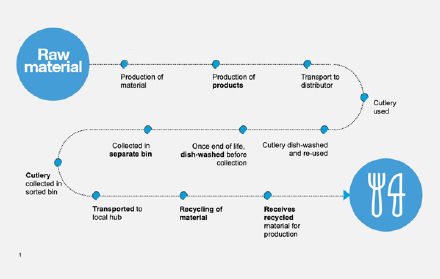Plastic cutlery is one of those items that traditionally will not be recycled even if it is placed in the recycling bin. It’s far too contaminated. It’s far too small. It’s far too light. As a result, over 40 billion plastic utensils used each year in the United States alone, are a complete waste. Source: Timberbiz
Stora Enso conducted a trial to test the advantages of biocomposite utensils.
But what makes the biocomposite cutlery even more remarkable is the fact that its dishwasher safe and allows for reusability.
The material can be collected, molded, and reused into a new product.
As a sponsor of the World Ski Championships, Stora Enso saw an opportunity to test the circular loop by replacing all single-use plastic cutlery with its biocomposite cutlery at the 2019 Seefeld World Ski Championships.
The goal was to collect, reuse, and recycle cutlery so that after the event, there would be nearly no plastic trash. Separate waste containers were erected throughout the eating areas to collect and separate cutlery from general waste. Amazingly, by the end of the Championship, 75% of the cutlery had been collected.
The 2019 experiment resulted in the development of a fully realistic cutlery circular loop. The two essentials in order to make the loop functional are that it is easy to gather and it is easy to clean the material.
Cleaning, in general, is a new step for vendors/restaurants to execute a circular loop as compared with a normal disposable cutlery. It must also be determined how and who is accountable for the collection and return of damaged cutlery.
Stora Enso has seen a surge of demand for its biocomposite cutlery. The EU directive aims to reduce plastic pollution caused by single-use plastics such as disposable cutlery.





